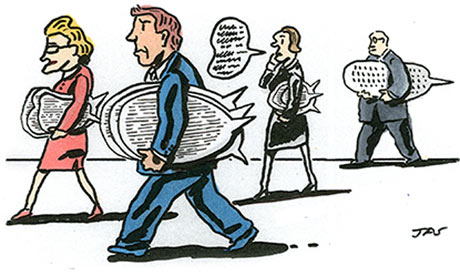Both sagas have their roots in dodgy academic papers, the agenda-pushing press and politicians – and willing believers

A measles outbreak in Swansea has affected 900 people. Photograph: Alamy
Dodgy research pushed by publicity-happy academics. False claims burnished into golden truths by irresponsible newspapers, apparently trying their hardest to manufacture a panic. Finally, the repercussions: bad decisions and, years later, huge worries about the harm posed to the public.
I'm describing the MMR scandal, the story of how one paper published in a top medical journal prompted a mass scare about a possible link between the triple jab and autism, and led to around one million children being deprived of full vaccinations against measles, mumps and rubella. It's been in the news again this week, following a measles outbreak in Swansea affecting 900 people, and worries that London may be next.
Yet listening to the radio discussions, a feeling nagged at me. Didn't this saga, with its origins going back more than a decade, sound similar to a more recent episode in a different field – the economics of austerity? Over the past fortnight, an academic paper regularly used by George Osborne to justify his cuts, public-sector redundancies and tax hikes has also been exposed as riddled with errors and dubious statistics.
At first, I'll admit, the comparison felt like too much of a stretch. On the one hand, there was Andrew Wakefield, the MMR heretic whose image would regularly flicker up on the 10 O'Clock News; on the other, there was Carmen Reinhart and Ken Rogoff, two Harvard economists of great renown – but hardly box-office. Wakefield was struck off for malpractice; Reinhart and Rogoff are guilty of no such breaches and their book on banking crises, This Time Is Different, will be considered a classic. MMR was a scare foisted on New Labour (remember those stories about whether baby Leo Blair had been injected?), which it had to defuse; this coalition has pushed austerity. The MMR debate boiled down to a question raised by every parent: should I vaccinate my child? The arguments about austerity can't be rendered in personal terms.
So much for the obvious caveats (there's one more, which I'll come to later). Yet whenever I raised the comparison with colleagues or others who had watched the cuts debate, nearly all saw the parallels. At the root of both sagas lies research, heavily contested then and now discredited, but given excessive credibility by outsiders in politics or the press – and used to push distinct agendas. That public-health scare from the turn of the noughties, and this public-finance panic from the start of this decade share common themes. Combined, we could call these lessons: how to flog a terrible idea.
Lesson 1: Have a suspicious public
For a terrible idea to take flight, the public must be in a receptive mood. The MMR scare was preceded by the mad-cow scandal, in which the government had kept insisting that British beef was safe. The arguments over austerity followed on the great bust of 2007-8 – and hadn't then-prime minister Gordon Brown promised to abolish boom and bust? In both cases, the press had been gulled by the official expertise. Do you remember those spreads in the Daily Mail about the coming chaos at RBS? No, I don't either.
Lesson 2: Bad ideas sound like common sense
The press had trusted establishment scientists and the economic technocrats; by the time MMR and the banking bust came along there was a market for policies that sounded easy to understand. So David Cameron really could get away likening the British economy to a household that had maxed out its credit card. It was nonsense, of course, but it was easy to understand nonsense. Unlike Bloomsbury-style Keynesianism, which was much more sensible amid a slump but was treated as far-out science to do with money supplies and fiscal multipliers.
Lesson 3: Bad ideas need strong supporters
My memories of the MMR story were to do with Wakefield. But when academics Tammy Speers and Justin Lewis looked at the news stories, they found that Wakefield got fewer mentions than baby Leo. The scare about MMR was never centred around a paper in the Lancet; rather, the research was recruited into the service of a general scare. That goes much more so for austerity, where the government here and the European troika used available research to push the cause of cuts and lay-offs. The Reinhart-Rogoff paper was published two years after Osborne had adopted austerity as his policy; academia provided justification, but they didn't change minds. And austerity has been fully cloaked in the language of morality: of debt being a bad thing, of southern Europeans being feckless.
The final caveat is: pure science lays much more emphasis on reproducing tests to see if the results bear up; macroeconomists can't run big experiments on entire countries to see which policies work, meaning that fights in the dismal science are necessarily more ideological (however disguised) than methodological. Yet so many economists hanker after hard science status there's even a term for it: "physics envy". Indeed, that key finding from Reinhart-Rogoff – that countries with debt of more than 90% of their GDP experience sharply slower growth – sounds like something you'd hear at the back of a school lab. But it isn't a rule at all: high debt can mean slow growth, but obviously so too can slow growth produce high debt. Still, whether MMR or austerity, the bottom line in both is that plausible science can make bad decisions seem sensible. When the science no longer seems implausible, the game is up. Wakefield was rumbled; slowly but surely the same is happening to the austerity-mongers.





